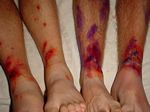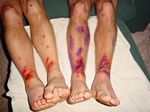| Home | > | List of notes | > | Note 2 |
Note 2: An encounter with the Blister bush (Diplolophium buchananii) by Gavin Stephens
This is an email sent to me by Gavin Stephens on 4 April, 2005 and describes the effects of an encounter with the Blister bush on his brother and himself during a run in the Chimanimani mountains.
Dear Mark
Thank-you for coming back to me (via Jonathan) with the information on the Chimanimani Blister Bush (Diplolophium buchananii). I have endeavoured to access your web-page (taking note of the changes you referred to) but have been unsuccessful this far. I see from your note that you wanted some information on the effects, so, from personal experience, here goes!
- Day 1
- Contact made with broken pieces of the plant (around my ankles in this case). If you brush past, then there is no problem. In our case one of two things occurred - A - Hikers in front of us unknowingly broke the plant, which we missed in the grass, or B - The plant got caught between the tongue of our boot and our ankle, and as we stepped forward we then stripped the leaves, or broke the stem, and so covered our ankles in the plant juice. Either way both Dessy and I were badly affected around the ankles, whilst a race colleague got it on his wrist and legs.
- Day 2
- No reaction. However the exposure to the UV light during the day would have set the chemical reaction in progress. If you covered the affected parts (i.e. protected them from UV light), then you would escape - but you do not know that you have been affected at this stage. I had cleaned my legs (whilst swimming) in a stream the day before - but it seems to no avail!
- Day 3
- Swelling of the parts that were affected (in my case my ankles, in others the wrist etc)
- Day 4
- Large and painful blisters, and clear red welts where ever the plant had touched me. Attempted to remain out of light. I recommend cleaning the injured sites, keeping dry, and treating with mercurochrome. We applied bandages to prevent the blister liquid from spreading - not totally successful as we were still competing in the Iron will race that day! In an ideal situation, keep the injured parts clean, dry and elevated. It is extremely painful, and will remain so for the next few days.
- Day 5
- Some blisters had burst, leaving a raw sore that continuously oozed. If this ooze made contact with undamaged skin, it started to burn. We spent the day trying to prevent this from happening, and treating the sores as described above.
- Day 6
- Large scabs formed over some of the sores.
- Day 7
- Dessy (and other affected competitors) visited a doctor and received anti-biotics for the possible infection, and a burn cream. However, the doctor had not seen this kind of wound before. We understand that presently there is no known treatment (I wonder if this is the case in SA?) and that it does not seem to affect the skin of indigenous persons, only us pale faces!
- Day 10
- The blisters started to dry out. I removed the external skin, cleaned, dried and treated with Mercurochrome the raw skin below. Dessy's sores remain wet and raw.
- Day 12
- Dessy's sores start to dry out.
The injuries were exacerbated due to the fact that they occurred on a part of the leg that receives poor circulation.
Prevention
- Wear longs (full protection, but hot and uncomfortable)
- Wear gaiters (not full leg protection)
- Wear socks (collect grass seeds)
- Keep a look out and try to avoid!
- Do not damage the plant as it affects those who follow!
| Home | > | List of notes | > | Note 2 |


